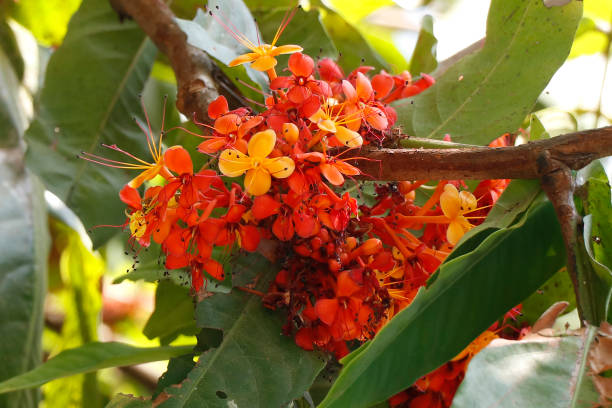India, a land blessed with diverse ecosystems and rich flora, is today grappling with one of the most pressing issues of modern times—air pollution. As urban centers expand and industrialization accelerates, planting trees with high oxygen production and air-purifying qualities becomes a vital step in reversing environmental damage. One such underappreciated but powerful tree is the Arjuna tree (Terminalia arjuna), often regarded as a silent guardian of ecological balance.
In this comprehensive guide, we explore why planting the Arjuna tree is a green revolution in itself, how it contributes to cleaner air, and why every Indian home, community park, and institution should consider including this tree in their green spaces.
What is the Arjuna Tree?
Native to India and other parts of South Asia, the Arjuna tree is a large, evergreen species known for its glossy green leaves and thick bark. Traditionally revered in Ayurvedic medicine, the tree is now emerging as a natural air purifier, making it an ecological asset for combating pollution.
- Botanical Name: Terminalia arjuna
- Common Name: Arjuna
- Height: Grows up to 60–90 feet
- Lifespan: Can live for over 100 years
- Regions Grown: Across plains and riverbanks in India
Its wide canopy and robust foliage make it excellent for urban afforestation, helping lower PM2.5 levels, combat urban heat islands, and improve biodiversity.
Environmental Benefits of Planting Arjuna Tree
1. Air Purification and Oxygen Release
One of the most remarkable traits of the Arjuna tree is its ability to release oxygen both during the day and in trace amounts at night, thanks to its Crassulacean Acid Metabolism (CAM)-like behavior.
It’s often planted alongside other oxygen-rich trees like the Peepal Tree: The Sacred Oxygen Giant Every Indian Should Plant and Banyan Tree: The Timeless Oxygen Factory of Indian Landscapes for its collective benefit to the local air quality.
2. Carbon Sequestration
With its dense wood and rapid growth, the Arjuna tree absorbs large amounts of carbon dioxide, locking it away in biomass and soil, thereby helping mitigate climate change.
3. Urban Heat Reduction
The tree’s expansive crown offers ample shade, reducing ground temperatures and combating the urban heat island effect, especially in densely populated Indian cities.
4. Water Conservation and Soil Stabilization
Found commonly along riverbanks, it has a deep-root system that helps control soil erosion, and it also conserves water by preventing runoff. Its presence improves groundwater recharge.
Medicinal and Cultural Significance
For centuries, the Arjuna tree has been central to Ayurvedic treatments, especially in strengthening heart health. The bark contains coenzyme Q10, antioxidants, and flavonoids which are used in herbal preparations for:
- Heart ailments
- High blood pressure
- Cholesterol control
- Respiratory issues
Its spiritual significance is also recognized in various Indian traditions, where it symbolizes strength, protection, and health.
How to Grow and Maintain the Arjuna Tree
Soil and Climate Requirements:
- Prefers loamy to clayey soils
- Thrives in tropical to subtropical climates
- Requires moderate watering
Planting Tips:
- Best planted in early monsoon
- Ensure adequate spacing of 5-6 meters between trees
- Use organic compost for initial growth
Maintenance:
- Minimal pruning required
- Pest-resistant by nature
- Water well during the first year
Why Arjuna Tree Should Be Part of Every Green Drive in India
Given India’s rising pollution levels and the health challenges linked to poor air quality, trees like the Arjuna serve as natural air filters. They’re easy to grow, require low maintenance, and deliver long-term ecological and health benefits.
When combined with other air-purifying trees like the Why Neem Tree Is India’s Most Powerful Air Purifier and Drumstick (Moringa) Tree: Nutrient-Rich and Oxygen-Producing Powerhouse, the Arjuna tree helps build a sustainable green ecosystem across both rural and urban landscapes.
Best Places to Plant Arjuna Trees in India
- Urban parks and roadsides
- School and college campuses
- Hospital grounds
- Community gardens
- Riverbanks and lakefronts
Its adaptability to various soil types and climates makes it a preferred choice in diverse regions—from Rajasthan’s plains to Kerala’s wetlands.
Combining Arjuna Tree with Other Oxygen-Rich Trees
For maximum ecological impact, it’s ideal to create oxygen parks or urban forests with a mix of native species. Some excellent companions to the Arjuna tree include:
- Planting Gulmohar: Beauty and Oxygen Combined in Indian Gardens for aesthetics and shade
- Saptaparni (Alstonia Scholaris): The Night-Time Oxygen Tree of India for night-time oxygen release
- Tamarind Tree: Shade, Sustainability, and Oxygen for Indian Climate for sustainability and culinary use
- Kadamba Tree: Mythological Charm with Oxygen-Rich Benefits for mythology and fragrance
Creating such biodiverse plantations not only improves air quality but also supports urban biodiversity by attracting pollinators, birds, and insects.
FAQs About Planting Arjuna Tree in India
Q1: Is the Arjuna tree suitable for small gardens?
While it is a large tree, it can be planted in large home gardens or community spaces. If space is limited, consult local horticulturists for dwarf varieties or alternatives.
Q2: How long does it take for the Arjuna tree to grow?
Under optimal conditions, it takes about 5-7 years to become a full-grown tree with significant canopy coverage.
Q3: Does the Arjuna tree attract pests?
The Arjuna tree is naturally pest-resistant, reducing the need for chemical pesticides.
Q4: Can the Arjuna tree survive in dry regions?
Yes, it can, provided there’s adequate watering during initial years. Once established, it is quite drought-resistant.
Q5: Is it safe to use bark directly for medicinal purposes?
It’s advisable to consult a certified Ayurvedic practitioner before using any part of the tree for health treatments.
Final Thoughts
Planting the Arjuna tree is more than a green choice—it’s a life-affirming act. Whether you’re a city dweller concerned about rising pollution or a rural homeowner looking to restore local ecology, this tree offers an accessible and sustainable solution.
Combine it with other green warriors like the Peepal Tree, Banyan Tree, and Neem Tree to create a truly oxygen-rich India.
Let’s plant the change we wish to breathe!
